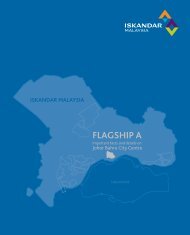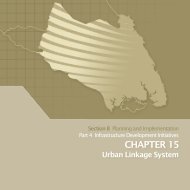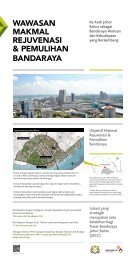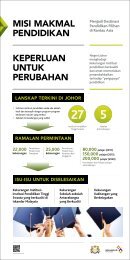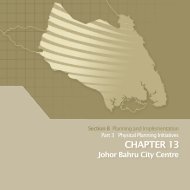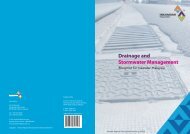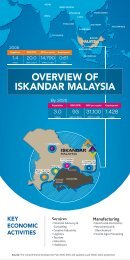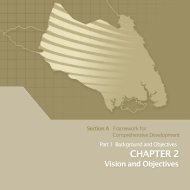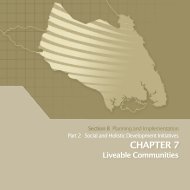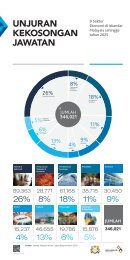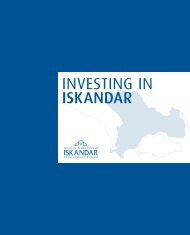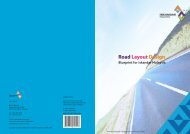transportation blueprint from 2010 to 2030 - Iskandar Malaysia
transportation blueprint from 2010 to 2030 - Iskandar Malaysia
transportation blueprint from 2010 to 2030 - Iskandar Malaysia
You also want an ePaper? Increase the reach of your titles
YUMPU automatically turns print PDFs into web optimized ePapers that Google loves.
Transportation<br />
Blueprint <strong>2010</strong> - <strong>2030</strong> for <strong>Iskandar</strong> <strong>Malaysia</strong><br />
TM<br />
Satellite Office:<br />
Main Office:<br />
#G-01, Block 8,<br />
Danga Bay, Jalan Skudai,<br />
80200 Johor Bahru, <strong>Malaysia</strong>.<br />
Tel: +607 233 3000<br />
Fax: +607 233 3001<br />
Suite 5-3, 5th Floor, Block 3B,<br />
Plaza Sentral, Jalan Stesen Sentral 5,<br />
50470 Kuala Lumpur, <strong>Malaysia</strong>.<br />
T +603 2260 6777<br />
F +603 2260 7999<br />
ISBN 978-967-5626-27-2<br />
E-mail: enquiries@irda.com.my<br />
<strong>Iskandar</strong> Service Centre: 1 800 88 3010<br />
www.iskandarmalaysia.com.my<br />
Copyright <strong>Iskandar</strong> Regional Development Authority (IRDA) 2011 9 789675 626272<br />
<strong>Iskandar</strong> Regional Development Authority (IRDA)
978-967-5626-27-2
Transportation Blueprint <strong>2010</strong>-<br />
<strong>2030</strong> for <strong>Iskandar</strong> <strong>Malaysia</strong>
ACKNOWLEDGEMENT<br />
List of agencies/ departments involved in developing the Transportation Blueprint for <strong>Iskandar</strong> <strong>Malaysia</strong><br />
Federal<br />
Kementerian Pengangkutan <strong>Malaysia</strong><br />
Suruhanjaya Pengangkutan Awam Darat (SPAD)<br />
Kementerian Kerjaraya <strong>Malaysia</strong><br />
State<br />
Unit Perancang Ekonomi Negeri Johor<br />
Suruhanjaya Pengangkutan Awam Darat Wilayah Selatan<br />
Majlis Bandaraya Johor Bahru<br />
Majlis Perbandaran Johor Bahru Tengah<br />
Majlis Perbandaran Pasir Gudang<br />
Majlis Perbandaran Kulaijaya<br />
Majlis Daerah Pontian<br />
Jabatan Perancang Bandar dan Desa<br />
Jabatan Kerja Raya Negeri Johor<br />
Jabatan Pengangkutan Jalan Negeri Johor<br />
Jabatan Keselamatan Jalan Raya Negeri Johor<br />
Jabatan Ketenteraman Awam dan Trafik Negeri<br />
Johor (PDRM)<br />
Jabatan Imigresen Negeri Johor<br />
Jabatan Kastam dan Eksais Diraja Negeri Johor<br />
Jabatan Perangkaan Negeri Johor<br />
Others<br />
Khazanah Nasional Berhad<br />
<strong>Iskandar</strong> Investment Berhad<br />
Keretapi Tanah Melayu Berhad<br />
Johor Port Berhad<br />
Senai Airport Terminal Berhad<br />
Pelabuhan Tanjung Pelepas Sdn. Bhd.<br />
Association of <strong>Malaysia</strong> Haulier (Johor)<br />
Johor Port Shipping and Forwarding Association<br />
Johor Freight Forwarding Association<br />
Federation of <strong>Malaysia</strong> Manufacturer (Johor)<br />
Handal Indah Sdn. Bhd.<br />
Syarikat Pengangkutan Maju Berhad<br />
Syarikat Kenderaan S&S Sdn. Bhd.<br />
Transit Link Sdn. Bhd.<br />
Damansara Asset Sdn. Bhd.<br />
Gabungan Persatuan Teksi Berdaftar Johor Bahru<br />
(GAPET)<br />
Advance Maintenance Precision Management<br />
Sdn. Bhd.<br />
Seri Alam Properties Sdn. Bhd.<br />
Nusajaya Land Sdn. Bhd.<br />
Austin Heights Sdn. Bhd.<br />
Permas Jaya Sdn. Bhd.<br />
Johor Land Berhad<br />
Danga Bay Sdn. Bhd.<br />
Focal Aims Sdn. Bhd.<br />
Mutiara Rini Sdn. Bhd.<br />
Uda Land (South)<br />
Consultants<br />
Urusbudi Transplan Sdn. Bhd.<br />
APDUG Sdn. Bhd.<br />
MN Consult Sdn. Bhd.
Foreword<br />
<strong>Iskandar</strong> <strong>Malaysia</strong> is a National Project <strong>to</strong> develop a vibrant new region at the southern gateway of<br />
Peninsular <strong>Malaysia</strong>. A regional authority body called <strong>Iskandar</strong> Regional Development Authority (IRDA)<br />
was developed <strong>to</strong> coordinate the main roles of planning, promoting and facilitating. In fact, IRDA has<br />
commissioned this Transportation Blueprint for <strong>Iskandar</strong> <strong>Malaysia</strong> <strong>to</strong> assist the public and private sec<strong>to</strong>r<br />
with the community <strong>to</strong> work <strong>to</strong>gether in developing a world class <strong>transportation</strong> system within<br />
<strong>Iskandar</strong> <strong>Malaysia</strong>, in order <strong>to</strong> make it as a place <strong>to</strong> invest, work, live and play.<br />
Transport Masterplan for <strong>2010</strong>- <strong>2030</strong> has been prepared <strong>to</strong> assist the public and private sec<strong>to</strong>r and the<br />
community <strong>to</strong> work <strong>to</strong>gether in managing the <strong>transportation</strong> concerns within the <strong>Iskandar</strong> <strong>Malaysia</strong><br />
region do that the benefit in making the region a best place <strong>to</strong> invest, work and play.<br />
The first focus will be on Public <strong>transportation</strong>. In <strong>Iskandar</strong> <strong>Malaysia</strong>, public <strong>transportation</strong> is planned <strong>to</strong><br />
be integrated <strong>to</strong> comprehensively serve the need of public in general, and the use of private vehicles will<br />
be made more efficient through equitable measures and use of resources that affords everyone <strong>to</strong> get<br />
where they want easier and faster<br />
By <strong>2030</strong>, <strong>Iskandar</strong> <strong>Malaysia</strong>’s population is expected <strong>to</strong> double <strong>from</strong> 1.5 million <strong>to</strong>day <strong>to</strong> about 3<br />
million. There will be massive changes <strong>to</strong> the <strong>Iskandar</strong> <strong>Malaysia</strong>’s landscape in 15 years, so there is an<br />
urgent need <strong>to</strong> properly plan now so that we are ready <strong>to</strong> meet the challenges <strong>to</strong> our <strong>transportation</strong><br />
needs as <strong>Iskandar</strong> <strong>Malaysia</strong> develops. Thus we have <strong>to</strong> come up with better and more efficient ways <strong>to</strong><br />
enhance the public <strong>transportation</strong> and its connectivity. And with plans and programmes are developed<br />
<strong>to</strong> ensure people have the available transport <strong>to</strong> move one place <strong>to</strong> another in convenience and with<br />
proper timing.<br />
<strong>Iskandar</strong> <strong>Malaysia</strong> must also play a significant role in the global arena <strong>to</strong> relate ourselves <strong>to</strong> global<br />
<strong>transportation</strong>. In tandem with <strong>Iskandar</strong> <strong>Malaysia</strong>’s vision <strong>to</strong> be a “Sustainable Metropolis of<br />
International Standing” and we have a duty <strong>to</strong> play this role in shaping and developing our region so<br />
that we develop it sensibly and sustainably. <strong>Iskandar</strong> <strong>Malaysia</strong> can be fully developed in<strong>to</strong> a metropolis<br />
and still be a low carbon society by taking heed of the green <strong>transportation</strong> operating in a lively city.<br />
The preparation of this Transportation Masterplan <strong>blueprint</strong> is therefore timely and critically needed <strong>to</strong><br />
address the public <strong>transportation</strong> issues, connectivity between one place <strong>to</strong> another and put some<br />
concerns on the environment as well. This <strong>blueprint</strong> has incorporated a set of eleven (11) main<br />
<strong>transportation</strong> initiatives that is critically address and tackle the region’s <strong>transportation</strong> issues as<br />
<strong>Iskandar</strong> <strong>Malaysia</strong> develops.<br />
To facilitate the implementation, the <strong>blueprint</strong> outlines a set of new coordinating structure <strong>to</strong> manage<br />
new partnerships expected <strong>to</strong> come <strong>from</strong> public agencies and private organisations working <strong>to</strong>gether<br />
on more complex programmes of Transportation Masterplan in <strong>Iskandar</strong> <strong>Malaysia</strong>. Consequently, we<br />
look forward <strong>to</strong> a metropolis that is well connected with reliable public <strong>transportation</strong> and other modes<br />
of <strong>transportation</strong> in order <strong>to</strong> invest, live, work and play within a Metropolis of an International<br />
Standard.
EXECUTIVE SUMMARY<br />
<strong>Iskandar</strong> <strong>Malaysia</strong> aims <strong>to</strong> be a strong sustainable metropolis of international standing. To achieve this<br />
vision, <strong>Iskandar</strong> <strong>Malaysia</strong> requires world class and sustainable <strong>transportation</strong> system.<br />
<strong>Iskandar</strong> <strong>Malaysia</strong> Development Authority (IRDA) prepared the <strong>Iskandar</strong> <strong>Malaysia</strong> Transportation<br />
<strong>blueprint</strong> which has been endorsed by the Government.<br />
This booklet is the public version of <strong>Iskandar</strong> <strong>Malaysia</strong> <strong>transportation</strong> <strong>blueprint</strong> and consist of three<br />
chapters:<br />
• Urban Transportation<br />
• Freight Transportation<br />
• Green Transportation<br />
The urban <strong>transportation</strong> <strong>blueprint</strong> encapsulate the transformation of public and private<br />
<strong>transportation</strong> within <strong>Iskandar</strong> <strong>Malaysia</strong> region <strong>from</strong> <strong>2010</strong> <strong>to</strong> <strong>2030</strong>. The main agenda is <strong>to</strong> resolve<br />
current issues and mitigate future challenges by way of a “two-pronged” strategy of “push and pull” in<br />
terms of improving the public <strong>transportation</strong> as the pull fac<strong>to</strong>r and regulating the private<br />
<strong>transportation</strong> as the push fac<strong>to</strong>r.<br />
The freight <strong>transportation</strong> <strong>blueprint</strong> aims <strong>to</strong> take advantage of <strong>Iskandar</strong> <strong>Malaysia</strong> strategic location in<br />
accordance <strong>to</strong> the global trade and transshipment. The strategy is basically <strong>to</strong> improve the region’s<br />
logistics and supply chain capacity and prepare the region <strong>to</strong> be ready for global competitions.<br />
The green <strong>transportation</strong> <strong>blueprint</strong> aims <strong>to</strong> bring global visibility for the region and make the region<br />
livable for the future generations. Green <strong>transportation</strong> is key <strong>to</strong> obtain environmental sustainability.<br />
Smart development of both transit and land use widely known as Transit Oriented Development (TOD)<br />
enables the policy makers <strong>to</strong> plan for future development in a more sustainable manner. Benefiting<br />
<strong>from</strong> adaptation of the advanced green technology both in the engines and alternative fuels is another<br />
means <strong>to</strong>wards low carbon region.<br />
viii
CONTENT<br />
URBAN TRANSPORTATION 1<br />
GLOBAL LOGISTICS HUB 10<br />
GREEN TRANSPORTATION 19<br />
ix
URBAN TRANSPORTATION<br />
Demand Responsive Mobility and Accessibility by way of<br />
an integrated multi-modal public transport system with<br />
priority for people not cars
THE CURRENT CHALLENGES<br />
Population And Labour Force<br />
Annual average growth (AAGR) between year<br />
2000-2025 is forecasted at 4.1% compared <strong>to</strong><br />
2.4% for the State of Johor. Whilst, the labour<br />
force forecasted at 1.8 mil by <strong>2030</strong>.<br />
Economic Growth<br />
Higher than The National Economic Model which<br />
<strong>to</strong> achieve a Gross National Income of at least USD<br />
17,000 per capita nationwide by 2020.<br />
Public Transport Modal Split<br />
Public transport modal split decline <strong>from</strong> 15%<br />
<strong>to</strong> 10% by <strong>2030</strong>.<br />
Rapid economic and land use growth increase the needs for<br />
livable living and workplace. Without control, land use<br />
development will continue sprawling over 68% urban area in<br />
<strong>Iskandar</strong> <strong>Malaysia</strong>. Unregulated public <strong>transportation</strong> services<br />
will reduce their efficiency and lead <strong>to</strong> high dependency on private<br />
car. Au<strong>to</strong>-ownership is expected <strong>to</strong> grow <strong>from</strong> 500 cars/1,000<br />
population (now) <strong>to</strong> more than 800 by 2025. Projected person trips will<br />
increase <strong>to</strong> 6.9mil (@ 2.3 trip/person). Private person trip is projected at 4.65 mil with 3.1mil cars @ 1.5<br />
car occupancy rate. Major roads <strong>to</strong> all 5 flagships of <strong>Iskandar</strong> <strong>Malaysia</strong> will be flooded with cars and<br />
over capacity during peak hour.<br />
Another 1,864 km of road infrastructure need <strong>to</strong> be build for<br />
the next 20 years (2.5 times investment as compared <strong>to</strong><br />
current road infrastructure) if nothing is done.<br />
If nothing is done, 13,554 <strong>to</strong>nes of GHG<br />
emission will be released for the next 20<br />
years.<br />
With decreasing reserve in fossil fuel, we will be facing not<br />
only subsidy and fuel price issues but an economic<br />
down-turn in near future.
CONGESTION IS NIGHTMARE — WALK FORWARD<br />
Imagine this…<br />
… wake up in the morning, singing while shower, get dress, have a cup of coffee and plan what <strong>to</strong> be done<br />
<strong>to</strong>day. Open the door… thousand of cars just behind the corner! Thinking how <strong>to</strong> go <strong>to</strong> work and creating<br />
new reason for being late again and…. all of us are thinking the same!<br />
All major <strong>transportation</strong> corridors in <strong>Iskandar</strong><br />
<strong>Malaysia</strong> projected <strong>to</strong> be 3 times or more congested<br />
than how they are <strong>to</strong>day. Those corridors are :<br />
Kulai—Senai—Skudai—JBCC, Ulu Tiram—Johor<br />
Jaya—Pandan—Sen<strong>to</strong>sa—JBCC, Nusajaya-Perling-<br />
Danga-JBCC and Pasir Gudang—Permas Jaya—JBCC /<br />
Perling. The volume on those roads are estimated <strong>to</strong><br />
be more than 1.5 times over their capacity.<br />
More sustainable approach is needed <strong>to</strong> strategically<br />
change the ‘hopeless’ scenario now for better future<br />
of our next generations. S<strong>to</strong>p building more roads,<br />
s<strong>to</strong>p polluting the environment and start <strong>to</strong> reduce<br />
energy consumption let us go green with public transport!<br />
In order <strong>to</strong> achieve sustainability, a set of strategies<br />
need <strong>to</strong> be formed. These are <strong>to</strong> support the main<br />
objective <strong>to</strong> INCREASE TRANSPORT MODAL SPLIT<br />
<strong>to</strong> 50% by <strong>2030</strong>. Two main strategies <strong>to</strong> achieve this<br />
objective are:<br />
1) To reduce au<strong>to</strong> dependency by reducing the road<br />
per capita travel (@800km/capita) and car<br />
ownership <strong>to</strong> 300 cars for every 1,000 population.<br />
2) To increase public transport ridership by using<br />
push and pull fac<strong>to</strong>rs such as reliable transit<br />
services, compact and self-sustain growth center,<br />
etc.<br />
Through the co-operation of all related agencies and<br />
public participation, <strong>Iskandar</strong> <strong>Malaysia</strong> will achieve<br />
the target for public transport modal split of 50% by<br />
the year <strong>2030</strong>.<br />
Open the door… people are walking and cycling on the well-connected cycle/pedestrian<br />
path <strong>to</strong> the nearest s<strong>to</strong>p <strong>to</strong> take the transit service on time!
DESIRED FUTURE<br />
The desired future encapsulate both public and private <strong>transportation</strong> modes. Public <strong>transportation</strong> in<br />
<strong>Iskandar</strong> <strong>Malaysia</strong> will be integrated <strong>to</strong> comprehensively serve the need of <strong>Iskandar</strong> <strong>Malaysia</strong> in order<br />
<strong>to</strong> increase the share of public <strong>transportation</strong>. Actions will be taken <strong>to</strong> make the use of private vehicles<br />
more efficient through equitable measures and use of resources that leads <strong>to</strong> reducing transport<br />
demand.<br />
Strategies<br />
In order <strong>to</strong> reach the desired future, strategies are formulated and shall put in<strong>to</strong> action through<br />
identified projects.<br />
The strategies for public <strong>transportation</strong> in<br />
<strong>Iskandar</strong> <strong>Malaysia</strong> are:<br />
1- Enhance Public Transport<br />
• Establish comprehensive and cost effective<br />
transit system<br />
• Provide convenient, reliable, safe and<br />
efficient transit system<br />
• Assure multi-modal public transport<br />
accessibility and demand responsive system<br />
available<br />
2- Improve Transit Industry Capacity<br />
• Institute strong public leadership and<br />
political will <strong>to</strong> deliver<br />
• Inculcate healthy competition and inclusive<br />
transit industry<br />
• Develop professional capacity in transit<br />
administration and operations<br />
3- Encourage Transit Patronage<br />
The strategies for private <strong>transportation</strong> in<br />
<strong>Iskandar</strong> <strong>Malaysia</strong> are:<br />
1- Optimized road network<br />
• Create clear road hierarchy<br />
• Optimized existing capacity and mitigate<br />
congestion<br />
• Establish traffic restricted zones<br />
2- Road for people not vehicles<br />
• Establish people friendly road design<br />
standards and policies<br />
• Execute and practice transit priority via<br />
Intelligent Transport System<br />
• Reduce au<strong>to</strong>-use convenience/speed within<br />
cordon areas<br />
3- Manage Road/Traffic Demand<br />
• Convenient park and ride at origins that<br />
integrate with transit<br />
• Institute traffic management and restrains<br />
and road pricing<br />
• Establish mobility management program<br />
• Maximize transit coverage and quality<br />
service provided<br />
• Ensure transit patronage preference policy<br />
over car use.<br />
• Provide comfortable and attractive public<br />
transport facilities and vehicles.
Strategies implementation vehicles<br />
The IM urban <strong>transportation</strong> strategies <strong>to</strong>wards the realization of the desired future are addressing the<br />
supply, the institutional framework required <strong>to</strong> deliver the supply <strong>to</strong> meet the demand and the demand<br />
itself. Thus, different actions are required <strong>to</strong> implement the strategies.
INSTITUTIONAL FRAMEWORK<br />
To ensure effective implementation of action plans, IRDA has initiated the establishment of the<br />
required institutional framework such as <strong>Iskandar</strong> <strong>Malaysia</strong> Transport Council (IMTC), Perbadanan<br />
Pengangkutan Awam <strong>Iskandar</strong> <strong>Malaysia</strong> (PAIM) and Pasukan Pengangkutan Persendirian <strong>Iskandar</strong><br />
<strong>Malaysia</strong> (PPIM) <strong>to</strong> spearhead the implementations of projects based on the approved plan and<br />
subsequently coordinate and enhance public and private <strong>transportation</strong> systems in <strong>Iskandar</strong> <strong>Malaysia</strong>.<br />
PAIM Policies and Planning Measures<br />
In order <strong>to</strong> cater for the second and third strategies, PAIM will create policies that encapsulate the<br />
future demands for urban <strong>transportation</strong> with urban development. This otherwise known as Transit<br />
Oriented Development (TOD) enables the <strong>to</strong>wn planners and policy makers <strong>to</strong> align the <strong>transportation</strong><br />
means with the actual needs and demands of the urban areas.<br />
City sprawling is a disease of modern cities, this makes the movement within the city troublesome,<br />
adding <strong>to</strong> the number of trips required <strong>to</strong> fulfill the daily life needs. Policies <strong>to</strong>wards more compact and<br />
dense cities are required <strong>to</strong> achieve <strong>to</strong> a more livable urban environments. Furthermore, the plans and<br />
policies <strong>to</strong>wards smarter cities and <strong>transportation</strong> will enable smoother mobility for the city<br />
inhabitants .<br />
TRANS-ISKANDAR<br />
Trans-<strong>Iskandar</strong>, the implementing arm of PAIM’s public <strong>transportation</strong> projects and suggest policies <strong>to</strong><br />
enhance the public <strong>transportation</strong> system in <strong>Iskandar</strong> <strong>Malaysia</strong>.<br />
Projects<br />
Descriptions<br />
1<br />
Integrated Transit Terminal Network<br />
JB Grand Sentral is the most important transport hub, integrated with JB Sentral,<br />
Pasir Gudang Sentral, Nusajaya Sentral and Senai Sentral and Gateway terminals<br />
in Larkin, Ulu Tiram, Senai Airport, Kulaijaya, Pekan Nanas and Tg Kupang through<br />
transport networks.<br />
2<br />
Bus Rapid Transit System<br />
The <strong>Iskandar</strong> <strong>Malaysia</strong> Bus Rapid Transit system consist of 10 lines and nearly 250<br />
stations and s<strong>to</strong>ps, covering 90% of <strong>transportation</strong> needs for the region. Initial<br />
phase of BRT will link down<strong>to</strong>wn Johor Bahru with Skudai, Johor Jaya and<br />
Nusajaya, where commuting gridlocks frequently occur.
Projects<br />
Descriptions<br />
3 Suburban Feeders and Transit Desa<br />
Residential feeder bus services will allow short local transit journeys <strong>from</strong><br />
neighbourhoods <strong>to</strong> the nearest transit stations and suburban activity centers.<br />
Transit Desa will serve rural regions outlying around the borders of <strong>Iskandar</strong><br />
<strong>Malaysia</strong>.<br />
4 Regional Rail Transit System<br />
<strong>Iskandar</strong> <strong>Malaysia</strong>’s Komuter train system will make the full use of the present<br />
KTM rail infrastructure <strong>to</strong> connect Nusajaya, Kulaijaya, Johor Bahru and Pasir<br />
Gudang <strong>to</strong>gether, via the JB Grand Sentral public <strong>transportation</strong> hub at Kempas.<br />
5<br />
Taxis and Demand Responsive<br />
Transport System<br />
Segments of the population that require specialized <strong>transportation</strong> services will be<br />
served with Demand Responsive Transit (DRT) services. Commuters who want a<br />
straight door-<strong>to</strong>-door journey right on the dot will opt for taxis, and rates can be<br />
reduced with pre-booking, transfers and ridesharing schemes. City taxi shall<br />
provide services within <strong>Iskandar</strong> <strong>Malaysia</strong> Region and five flagships areas.<br />
6 Water Taxis, Ferries and Cruise<br />
Water taxis will operate <strong>from</strong> ferry terminals at Danga Bay, Stulang and Puteri<br />
Harbour for trips along the Tebrau straits and for escapades <strong>to</strong> Kongkong and<br />
Ramsar via Kukup and Tanjung Belungkor ferry terminals. River cruise <strong>to</strong>urs will be<br />
offered in the environmentally preserved areas of Kongkong and Ramsar, where no<br />
other modes of transport will be allowed.<br />
7 Inter-city and high speed transit<br />
Business and frequent travelers can avoid cross-border congestion on the<br />
causeway with the proposed Rail Transit System (RTS) that will link Johor Bahru<br />
and Singapore. Cross-border commuters will have the choice for direct bus<br />
services between <strong>Iskandar</strong> <strong>Malaysia</strong> flagships and other destination within the<br />
Peninsular. Also in the plan is the High Speed Rail service, which will link Johor<br />
Bahru with Kuala Lumpur and other important destinations in Peninsula <strong>Malaysia</strong>.<br />
8 School bus zoning<br />
School bus zones will be established at eight different zones within <strong>Iskandar</strong><br />
<strong>Malaysia</strong> and with the zoning system, school bus opera<strong>to</strong>rs are assigned <strong>to</strong> serve<br />
students and schools in accordance <strong>to</strong> specific zones.
TRAFIK-ISKANDAR<br />
Policies and plans will be put in place <strong>to</strong> manage the private <strong>transportation</strong> and several key projects have<br />
been identified for implementation as follows:<br />
Projects<br />
Descriptions<br />
1 Hierarchy of Roads and Highways<br />
The hierarchy of the Road and highway network in <strong>Iskandar</strong> <strong>Malaysia</strong> will be<br />
rationalized <strong>to</strong> ensure smooth travel for all vehicles. The higher the speed limit for<br />
a given road is, the lesser the access it has <strong>to</strong> surrounding places, and the lower the<br />
speed limit for a given road is, the higher the access it has <strong>to</strong> surrounding places.<br />
2<br />
Parking Management and Park-and<br />
-ride<br />
As the public mode remains a greater priority, car parks will be built more at<br />
origins, rather than destinations. Large park and ride facilities will be built adjacent<br />
<strong>to</strong> BRT and Komuter stations with sparser and lower density surrounding s. Parking<br />
spaces for cars and mo<strong>to</strong>rbikes, and bike racks for cyclists will be located at bus<br />
s<strong>to</strong>ps frequented by local feeder buses.<br />
3 Mobility Management<br />
By <strong>2030</strong>, <strong>Iskandar</strong> <strong>Malaysia</strong> aims that more than half of the commuting trips will<br />
be made via public transport (60% transit modal share) with the implementation<br />
of Transportation Demand Management (TDM). <strong>Iskandar</strong> <strong>Malaysia</strong>’s Mobility<br />
Centers will be set up <strong>to</strong> coordinate all <strong>transportation</strong> infrastructure and support<br />
systems in the region <strong>to</strong> facilitate the movement of people instead of private<br />
vehicles.<br />
4 Traffic Restraints and Road Pricing<br />
Urban areas will be classified as traffic restraint zones, where entering mo<strong>to</strong>rists<br />
will have <strong>to</strong> pay a fair amount of fee that will be continually adjusted <strong>to</strong> ensure<br />
those who choose <strong>to</strong> drive can run their errands stress-free. Greater enforcements<br />
and restrictions will ensure mo<strong>to</strong>rcyclists do not eat up pedestrian spaces<br />
5 Pedestrianization<br />
The livelihood and livability of the residential areas are improved through<br />
pedestrian-friendly suburban road layout that allow greater pedestrian<br />
accessibility, connectivity and convenience.
TRANSFORMATION PLAN<br />
Mind The Gap<br />
Build Momentum<br />
Sustain Growth<br />
Feeder Service<br />
Phase 3<br />
Congestion Pricing<br />
IM Komuter Rail<br />
ITT Phase 3<br />
BRT Phase 3<br />
High-speed Rail<br />
ITT Phase 2<br />
Feeder Service<br />
Phase 2<br />
Down<strong>to</strong>wn People<br />
mover<br />
BRT Phase 2<br />
Common Ticketing<br />
ITT Phase 1<br />
Feeder Service Phase 1<br />
RTS Crossborder<br />
Rail<br />
Parking Phase 3<br />
Taxi & DRT<br />
Active Transport<br />
BRT Phase 1<br />
Parking Phase 1<br />
Parking Phase 2<br />
Traffic Restraints<br />
Taxi & School Bus Reform<br />
ITS<br />
Water Taxi Introduction<br />
Pedestrianization<br />
Mobility Management<br />
50% PT<br />
Share<br />
PAIM<br />
IMTC<br />
PPIM<br />
CIQ Traffic Management<br />
Road Hierarchy<br />
35% PT<br />
Share<br />
Bextra<br />
BIM<br />
25% PT<br />
Share<br />
15% PT<br />
Share<br />
<strong>2010</strong> 2015 2020 <strong>2030</strong>
GLOBAL LOGISTIC HUB<br />
Efficient and competitive logistics & freight transport system in<br />
<strong>Iskandar</strong> <strong>Malaysia</strong>.
ROAD LESS TRAVELED<br />
Logistics industry in <strong>Malaysia</strong> covers four main modes of <strong>transportation</strong> – sea, land, air and rail. Logistics<br />
management is a neglected area of business in <strong>Malaysia</strong> causing the country <strong>to</strong> be left far behind <strong>from</strong><br />
its neighbour, also world’s best, Singapore.<br />
ISSUES<br />
High Heavy Vehicle Volume<br />
• Certain roads and highways congested due <strong>to</strong><br />
heavy vehicle traffic.<br />
• Heavy vehicle movements in the city centre cause<br />
congestion on local and urban streets.<br />
• Cargo movement growth expected <strong>to</strong> double as<br />
economy and trade expand.<br />
Unhealthy Competition<br />
• Unhealthy competition among haulag e<br />
opera<strong>to</strong>rs.<br />
• Weak and fragmented logistic industry<br />
institutional framework.<br />
• Industry players work in isolation under<br />
competitive pressure with no sharing of logistic<br />
information and planning.<br />
Poor urban logistics<br />
• No proper loading/unloading areas, especially in<br />
commercial areas.<br />
• Heavy vehicles parked indiscriminately in housing<br />
estates and road sides.<br />
• Poor urban logistics makes city centre and<br />
residential areas chaotic and less livable.<br />
Poor logistics infrastructure<br />
• Lack of logistics infrastructure <strong>to</strong> support growth<br />
of cargo movements and throughput expected in<br />
<strong>Iskandar</strong> <strong>Malaysia</strong> sea ports and airport.<br />
• Less logistic system performance <strong>to</strong> provide<br />
efficient and reliable and competitive cost for<br />
global trade.<br />
Lack of Inter-modal choice<br />
• Over dependence on road than rail as there is a<br />
lack of rail access <strong>to</strong> industrial areas.<br />
• Terminals, industrial and commercial spatial<br />
locations lack of optimum connectivity and<br />
accessibility by road and rail.<br />
Under usage of ICT in logistics<br />
• Lack of adaptation of advances in supply chain<br />
management and lagged in leveraging ICT<br />
systems by industry players.<br />
• Outdated supply chain and logistics practices.<br />
Pollution<br />
• Over reliance on fossil fuel by trucks and being a<br />
main contribu<strong>to</strong>r <strong>to</strong> GHG emission.
Status quo future scenario<br />
<strong>Iskandar</strong> <strong>Malaysia</strong> is located just next door <strong>to</strong> one of World’s best transshipment and trade hub (i.e.<br />
Singapore). The declining Western economy has driven and also caused the raise of global trade in the<br />
Asian region. This new economic trend is a golden bridge for Asian countries especially those along<br />
popular trade routes like Singapore and especially, <strong>Iskandar</strong> <strong>Malaysia</strong>.<br />
As of the year 2011, <strong>Malaysia</strong> is ranked number 29 in the World Bank’s International Logistics<br />
Performance Index (LPI) with Singapore at number 2. With the strait’s load of 200million TEU passing<br />
annually and Singapore’s capacity of 50 million TEUs annually, there is a sea of opportunities for<br />
<strong>Iskandar</strong> <strong>Malaysia</strong> <strong>to</strong> take advantage <strong>from</strong>. The Pelabuhan Tanjung Pelepas (PTP) for example, currently<br />
houses 14 berths and handles slightly over 6 million TEUs annually and is potential <strong>to</strong> expand up <strong>to</strong> 95<br />
berths with 150 million TEU handling capacity.<br />
However, without further efforts <strong>to</strong> develop its logistics system, <strong>Iskandar</strong> <strong>Malaysia</strong>’s potential of<br />
relieving <strong>Malaysia</strong>’s his<strong>to</strong>ry as one of world’s most important trade hub may just pass <strong>to</strong> waste.
MISSION<br />
Efficient and competitive logistics & freight transport<br />
system in <strong>Iskandar</strong> <strong>Malaysia</strong>.<br />
GOALS<br />
• To enhance goods and services linkages and<br />
movement with priority <strong>to</strong> rail modes and leverage<br />
on ICT.<br />
• To optimize land freight transport system by<br />
effective and secured multi-modalism and<br />
competitive logistics options.<br />
• To reduce congestion caused by freight traffic by<br />
optimizing road and rail usage and system capacity.<br />
• To elevate usage of green freight transport mode<br />
and industry awareness.<br />
• To re-align freight and logistics institution and<br />
human capacity building <strong>to</strong>wards achieving<br />
sustainable transport system for global<br />
competitiveness.<br />
• To optimize freight transport facilities and terminals<br />
via integrated and efficient supply chain<br />
manag ement and network for global<br />
competitiveness.<br />
STRATEGIES<br />
1-Transform Logistics Infrastructure<br />
• Designated truck routes and corridors,<br />
connecting major terminals and logistic hubs.<br />
• State of the art logistic park with distribution<br />
center and holding areas away <strong>from</strong> commercial<br />
and populated districts.<br />
2- Revolutionize Logistic Industry<br />
• Restructured road and rail transport network and<br />
services <strong>to</strong> optimize connectivity and<br />
accessibility for goods <strong>to</strong>/<strong>from</strong> terminals and<br />
industrial zones <strong>to</strong> meet growing goods<br />
movement<br />
• New age logistics practices such as e-logistics<br />
with competitive supply chain management<br />
facilities and services.<br />
3- Manage Urban Logistics<br />
• Stronger logistics framework that emphasizes on<br />
the management of the industry development<br />
that will facilitate trade and encourage<br />
competition among players.<br />
• Supply Chain Management and information<br />
technology as key drivers <strong>to</strong> productivity and<br />
efficiency in growth and competitiveness within<br />
the industry.
Action Plan<br />
Key strategies and policies are translated in<strong>to</strong> action plans <strong>to</strong> be implemented in form of projects <strong>to</strong><br />
transform and improve logistics operations and service delivery..<br />
Strategy 1 Strategy 2 Strategy 3<br />
Establish clear truck route and<br />
corridors<br />
Establish e-logistics, 4PL, 5PL<br />
systems<br />
Establish fringe warehouse and<br />
distribution park system<br />
ACTION PLAN<br />
Develop logistics park and<br />
villages<br />
Upgrade logistics supply chain<br />
management professional skill<br />
Establish logistics traffic<br />
management policies<br />
Create multimodal rail based<br />
logistic system<br />
Develop supply Chain<br />
Management facilities and<br />
services<br />
Establish logistics mobility<br />
management program<br />
INSTITUTIONAL FRAMEWORK<br />
Under IMTC, a special purpose vehicle namely Pengangkutan Logistik <strong>Iskandar</strong> <strong>Malaysia</strong> (PLIM) shall be<br />
established <strong>to</strong> formulate plans, strategies and policies, and implement them.<br />
LOGISTIK-ISKANDAR<br />
Under the management of PLIM and through Logistik-<strong>Iskandar</strong>, multi-modal logistics and freight<br />
networks become fully utilized <strong>to</strong> bring about the smooth movement and <strong>transportation</strong> of goods<br />
and freights.<br />
Logistik-<strong>Iskandar</strong> shall take advantage of the strategic location of <strong>Iskandar</strong> <strong>Malaysia</strong>, the current global<br />
economy and the opportunities arise <strong>from</strong> the popular logistics route in the South Asian region.<br />
Logistik-<strong>Iskandar</strong> will take the required actions in various development projects <strong>to</strong> improve the<br />
infrastructure and road networks required for smooth logistic operations and cater for the development<br />
of terminals and port. Further more, Logistic-<strong>Iskandar</strong> will utilize advanced technologies <strong>to</strong> implement<br />
e-logistics in order <strong>to</strong> facilitate the logistics and freight movements within and outside of the region.<br />
The strength of Logistik-<strong>Iskandar</strong> lies within the powerful Supply Chain Management practice,<br />
benefiting <strong>from</strong> the integrated facilities and infrastructure available in the region such as logistic parks,<br />
industrial parks and freight networks.<br />
14
Projects<br />
Descriptions<br />
1<br />
Terminals & Ports<br />
The <strong>Iskandar</strong> <strong>Malaysia</strong> region comprises of 4 major logistics and <strong>transportation</strong><br />
hubs – Senai International Airport, Port of Tanjung Pelepas, Tanjung Langsat Port<br />
and Pasir Gudang Port. The planned highway development connecting the airport<br />
and the ports will strengthen and support the growth of each individual facility.<br />
2 Senai Airport City<br />
2,718.68 acres development includes:<br />
• Cargo Agents Warehouse and GSA Offices<br />
• Senai Lives<strong>to</strong>ck Gateway<br />
• Senai Free Zone<br />
• Senai Logistics Park<br />
• Distribution and Trade Centre<br />
• Maintenance, Repair and Overhaul Centre<br />
• Oil and Gas Supply Base<br />
3<br />
Truck Routes<br />
To overcome the issue of traffic mismatch (between heavy and light vehicles) and<br />
public road safety, designated truck routes / corridors are needed <strong>to</strong> connect<br />
major terminals and logistic hubs.<br />
4<br />
Free Trade Zones (FTZ) &<br />
Industrial Areas<br />
Free Trade Zones (FTZ) will be developed as part of the economic development<br />
plan. Normal trade barriers such as tariffs and quotas are eliminated<br />
and bureaucratic requirements are lowered in hopes of attracting foreign<br />
investments. 3 new FTZ namely Nusajaya FTZ (2015), Seelong FTZ (2025), and Ulu<br />
Tiram FTZ (2025) will be developed in line with <strong>Iskandar</strong> <strong>Malaysia</strong>’s goal <strong>to</strong><br />
contribute <strong>to</strong> the country’s economy.<br />
5 Integrated Logistic Centers (ILC)<br />
Four Integrated Logistic Centers (ILC) will be developed <strong>to</strong> compliment the ports<br />
and FTZs in <strong>Iskandar</strong> <strong>Malaysia</strong>, they are Nusajaya ILC (2015), Kota Masai ILC<br />
(2015), Seelong ILC (2025 and Ulu Tiram ILC (2025).<br />
6 E-Logistics<br />
Practicality should be given a priority at all levels within the logistics process, in<br />
line with Logistik-<strong>Iskandar</strong>’s goal <strong>to</strong> enhance goods and services linkages and<br />
movement with priority <strong>to</strong> rail modes and leveraging on ICT.<br />
Map of the planned truck routes within <strong>Iskandar</strong> region<br />
Integrated Logistics & Distribution centers<br />
15
Projects<br />
Descriptions<br />
7<br />
Multimodalism & Containerization<br />
In line with the objective <strong>to</strong> improve trade efficiency and enhance logistics<br />
systems, a multimodal <strong>transportation</strong> network will be further developed. About<br />
RM2.7 billion will be invested <strong>to</strong> build roads and rail leading <strong>to</strong> key ports and<br />
airports while logistics manag ement will be improved <strong>to</strong> enhance efficiency of<br />
cargo <strong>transportation</strong> through rail, ports and airports<br />
8<br />
Supply Chain Management<br />
Competency<br />
A strategic supply chain is the backbone of an efficient logistics plan. Supply Chain<br />
Management (SCM) <strong>Iskandar</strong> is vision <strong>to</strong> be an organization that will developed<br />
supply chain practices within the region and produce world class professionals in<br />
the field. SCM <strong>Iskandar</strong> is supported by <strong>Iskandar</strong> <strong>Malaysia</strong>’s e-Logistics, truck<br />
routes, logistic parks, industrial parks and freight networks<br />
9 Urban Logistics Management<br />
Urban freight transport and logistic operations involved the activities of delivering<br />
and collecting goods in <strong>to</strong>wn and city centers. These activities are often referred <strong>to</strong><br />
as ‘city logistics’ as it covers the process of <strong>transportation</strong>, handling and s<strong>to</strong>rage of<br />
goods, the manag ement of inven<strong>to</strong>ry, waste and returns as well as home delivery<br />
services.<br />
16
TRANSFORMATION PLAN<br />
Revive the Potentials Lead the Way Global Competitiveness<br />
Free Trade Zones & Hub<br />
Global<br />
SCM Services Deployment<br />
Logistics Parks<br />
Multimodal Logistics & SCM<br />
Integrated Logistics Center<br />
Port upgrading<br />
Freight Rail<br />
Port Development<br />
Smart Logistics<br />
Truck Routes<br />
Regional Transshipment<br />
Integrated SCM<br />
Green Logistics<br />
E-logistics Trade Facilitation<br />
E-Logistics Database<br />
Devel-<br />
SCM Capacity<br />
opment<br />
Urban Freight Management<br />
LPI Rank<br />
5th<br />
Industrial Masterplan<br />
Port & Terminal Master plan<br />
LPI Rank<br />
15th<br />
PLIM<br />
IMTC<br />
LPI Rank<br />
25th<br />
LPI Rank<br />
29th<br />
<strong>2010</strong> 2015 2020 <strong>2030</strong><br />
17
GREEN TRANSPORTATION<br />
Green Transportation System <strong>to</strong>wards sustainable land use and<br />
environment in <strong>Iskandar</strong> <strong>Malaysia</strong>
PROBLEMS, ISSUES AND CHALLENGES<br />
Unsustainable trend<br />
The challenges for the transport sec<strong>to</strong>r in becoming “green” are made obvious by observing current<br />
trends, whereby:<br />
• Overall demand for transport activity (for both passenger and freight) is growing rapidly, and it is<br />
predicted <strong>to</strong> roughly double between <strong>2010</strong> and 2020<br />
• Transport activity is increasingly mo<strong>to</strong>rized (private cars for passenger transport and lorries for<br />
freight, almost all of which are propelled by internal combustion engines);<br />
• The global vehicle fleet is set <strong>to</strong> multiply three or four-fold in the next few decades, with most of this<br />
growth set <strong>to</strong> occur in developing countries. In 2050, two-thirds of the global vehicle fleet is<br />
expected <strong>to</strong> be in non-OECD countries; and<br />
• Technological improvements such as fuel-efficient vehicles and alternative power sources have not<br />
been rapid enough <strong>to</strong> offset the impacts of this growth.<br />
These trends translate directly in<strong>to</strong> various costs for the environment, society and economy:<br />
• Energy consumption and greenhouse gas emissions;<br />
• Congestion (and associated losses in productivity of urban areas);<br />
• Resource depletion and land grab;<br />
• Degradation of human health (through air pollution, noise, vibration, etc);<br />
• Reduction in human security (through traffic accidents);<br />
• Reduction of accessibility and severance of communities; and<br />
• Loss of biodiversity.<br />
Strategies are <strong>to</strong> be formulated and actions are <strong>to</strong> be taken <strong>to</strong> reduce the controversial affects of<br />
current trends or else our next generation will face lots of difficulties and problems in their life. The<br />
future urban challenges if we don’t take actions now would be :<br />
• The urban sprawl is spreading <strong>from</strong> Johor Bahru City Centre <strong>to</strong> east, north-east, north and western<br />
then <strong>to</strong>ward south-west area via major roads.<br />
• Coverage of public transport corridor is still small and along existing development corridor – Jalan<br />
Skudai, Jalan Tebrau, Lebuhraya Pasir Gudang & JB Parkway.<br />
• High commuting pattern <strong>from</strong> fringe residential areas in particular <strong>from</strong> Kulai, Senai & Skudai and<br />
Plen<strong>to</strong>ng in<strong>to</strong> Johor Bahru city and <strong>from</strong> Johor Bahru city and surrounding residential areas <strong>to</strong> Pasir<br />
Gudang and Tanjung Langsat.<br />
• Pressure for development in greenfield sites especially in agricultural land located at the fringe of<br />
existing urban corridor. Development on existing agriculture land is unavoidable as estates owner<br />
likely <strong>to</strong> convert their land in<strong>to</strong> mix development use. Impact on <strong>transportation</strong> not always be the<br />
priority.<br />
20
THE DESIRED FUTURE<br />
The most desired future for <strong>Iskandar</strong> <strong>Malaysia</strong> region is a sustainable environment which only can be<br />
gained through environment protective measures. Going green is the current movement <strong>to</strong>wards better<br />
and more sustainable environment.<br />
Green <strong>transportation</strong> and development are means <strong>to</strong> realize this goal of the sustainable environment.<br />
Green Goals<br />
The Goals <strong>to</strong>wards the sustainable <strong>Iskandar</strong> <strong>Malaysia</strong> are:<br />
To have an economically and environmentally viable urban <strong>transportation</strong> system<br />
To encourage optimum density and intensity of land use <strong>to</strong>wards achieving sustainable urban<br />
development and healthy lifestyle<br />
To encourage patronage and social opportunity through equitable accessibility and affordability of<br />
transport<br />
To strengthen the effectiveness of transport institution and human capacity building <strong>to</strong>wards<br />
achieving sustainable transport<br />
To elevate the environmental quality through adaptation of green technology transport with<br />
consumer support<br />
To improve the quality of transport corridor and facilities incorporating network of pedestrianization<br />
and non-mo<strong>to</strong>rization<br />
22
STRATEGIES<br />
Green Transportation Benefits<br />
1– Economic sustainability<br />
• Ensure transit operations commercial sustainability<br />
• Ensure logistic operations commercial sustainability<br />
Increases energy security as less oil needs<br />
<strong>to</strong> be imported. Resource conflicts can be<br />
avoided and transport users won’t have<br />
<strong>to</strong> suffer <strong>from</strong> fuel price shocks<br />
2- Environmental Sustainability<br />
• Establish environmental moni<strong>to</strong>ring and control<br />
• Establish recycling and carbon credit program<br />
Reduc es tra f fic cong e sti on, and<br />
consequently air and noise pollutions are<br />
reduced, having a positive impact on the<br />
environment and human health<br />
3– Social Equity Sustainability<br />
• Ensure universal accessibility and affordability<br />
• Institute transport training and career development<br />
Reduces land demand by preventing urban<br />
sprawl and preferring semi-dense<br />
mixed-use neighborhoods<br />
• Provide public/low cost housing for transport workers<br />
4– Green Transport<br />
• Promote renewable energy/ Energy efficient use<br />
• Establish green transport policies and guidelines<br />
• Promotion of active transport network and social activities.<br />
Provides visibility and acknowledgement of<br />
cities that demonstrate leadership:<br />
s u s t a in a bl e an d m od e rn g r e e n<br />
<strong>transportation</strong> systems<br />
Improving vehicle and fuel technology <strong>to</strong> reduce adverse environmental effects such as pollution<br />
and resource depletion.<br />
23
The action plan<br />
The green strategies are translated in<strong>to</strong> projects and development actions <strong>to</strong> pave the way <strong>to</strong> realize a<br />
green and sustainable <strong>Iskandar</strong> <strong>Malaysia</strong>.<br />
The actions focus on shifting the paradigm <strong>from</strong> current trends <strong>to</strong> a more environmentally friendly<br />
behaviours. This can only happen provided that the required infrastructure are in place.<br />
Strategy 1 Strategy 2 Strategy 3 Strategy 4<br />
integrating land-use and<br />
transport planning;<br />
Green technology<br />
designing denser and<br />
more compact<br />
settlements<br />
Carbon credit program<br />
Smart land use<br />
development<br />
Pedestrianization and<br />
cycling lane<br />
harnessing<br />
telecommunication<br />
optimizing logistics <strong>to</strong><br />
reduce empty runs and<br />
Promotion of<br />
alternative<br />
environmental friendly<br />
fuel<br />
Smart Transportation<br />
development<br />
Promotion of<br />
non-mo<strong>to</strong>rized transit<br />
Green transport Policy<br />
ensure a high load fac<strong>to</strong>r.<br />
INSTITUTIONAL FRAMEWORK<br />
Under IMTC a special purpose vehicle by the name of Pengangkutan Hijau <strong>Iskandar</strong> <strong>Malaysia</strong> (PHIM)<br />
shall be established <strong>to</strong> formulate plans, strategies and policies related <strong>to</strong> green <strong>Iskandar</strong> <strong>Malaysia</strong>.<br />
PHIM will introduce Green-<strong>Iskandar</strong> <strong>to</strong> spearhead projects related <strong>to</strong> sustainable environment. Green-<br />
<strong>Iskandar</strong> will work very closely with state and federal agencies <strong>to</strong> achieve <strong>Iskandar</strong> <strong>Malaysia</strong> green<br />
objectives subsequently live up <strong>to</strong> the national aspirations.<br />
24
GREEN-ISKANDAR<br />
Green-<strong>Iskandar</strong> is the implementing arm of the PHIM, <strong>to</strong> undertake projects and action plans <strong>to</strong> achieve<br />
sustainability. The following are key actions that will be carried out by Green <strong>Iskandar</strong>:<br />
Smart Growth :<br />
Toward sustainable land use development<br />
The Smart Growth concept of land use development is<br />
the desirable measure <strong>to</strong> sustain population and<br />
employment growth in <strong>Iskandar</strong> <strong>Malaysia</strong>. Resources<br />
need <strong>to</strong> be utilized in balance and profitable manner<br />
<strong>to</strong> benefit the community. Towards implementing the<br />
Smart Growth land use development, new<br />
development approaches such as Compact City, Green<br />
City and Intelligent City can be grouped in one<br />
concept: Transit Oriented Development (TOD). Transit<br />
corridors along major BRT lines were designed <strong>to</strong><br />
accommodate nearly 90% coverage of urban land use<br />
in <strong>Iskandar</strong> <strong>Malaysia</strong>.<br />
Improving vehicle and fuel technology <strong>to</strong><br />
reduce adverse environmental effects such as<br />
pollution and resource depletion.<br />
Enhancing the fuel economy of conventional<br />
engines, reducing the weight of vehicles and<br />
developing alternatives such as electric and<br />
hybrid vehicles, bio-fuels, and hydrogen fuel<br />
technologies are all examples of this strategy.<br />
Further efficiency gains can be achieved<br />
through an improvement in the occupancy rate<br />
of vehicles, or through better driving (ecodriving).<br />
Given that transport systems vary<br />
greatly around the world, it is important <strong>to</strong> fully<br />
consider the context and main problems facing<br />
each region. Many developing countries are<br />
heavily reliant upon non-mo<strong>to</strong>rized transport<br />
and therefore present opportunities for<br />
creating more sustainable transport systems<br />
than those in developed nations.<br />
25
Transit Oriented Development (TOD)<br />
A transit-oriented development (TOD) is a mixed-use residential or commercial area designed <strong>to</strong><br />
maximize access <strong>to</strong> public transport, and often incorporates features <strong>to</strong> encourage transit ridership.<br />
GENERAL TOD POLICIES<br />
♦<br />
♦<br />
♦<br />
♦<br />
♦<br />
♦<br />
ENSURE TRANSIT SUPPORTIVE LAND USES<br />
INCREASE DENSITY<br />
PEDESTRIAN-ORIENTED DESIGN<br />
MAKE EACH STATION AREA A “PLACE”<br />
MANAGE PARKING, BUS AND VEHICULAR<br />
TRAFFIC<br />
PLAN IN CONTEXT WITH LOCAL<br />
COMMUNITIES<br />
Green Building Development<br />
The growing trend <strong>to</strong>wards green and sustainable<br />
development offers many opportunities for builders<br />
and land developers. General society and the<br />
market are now calling for greater and greater<br />
number of green products, structures, and<br />
communities. IRDA and other local jurisdictions in<br />
<strong>Iskandar</strong> <strong>Malaysia</strong> will strongly pursue their ability <strong>to</strong><br />
do green and sustainable development with new<br />
paradigm in planning, developing and maintaining it.<br />
26
Projects<br />
Description<br />
1<br />
Transit Oriented Development Grand<br />
and Flagships Central<br />
All multi-modal transport terminals must be designed and<br />
integrated with high density mix development properties.<br />
Implementation of TOD concept for multi-modal terminals will be<br />
imposed after 2013. 500 acres of land around the multi-modal<br />
terminals are targeted <strong>to</strong> be fully developed by <strong>2030</strong>.<br />
2<br />
Transit Oriented Development at<br />
Getaway Terminals & stations<br />
With allowable plot ratio of 3.5 <strong>to</strong> 7.5, 125 acres of land around 6<br />
gateway terminals targeted <strong>to</strong> be fully developed by <strong>2030</strong>. The<br />
same TOD concept for terminals applied at all transit stations.<br />
Conceptual Design and land use planning for:<br />
3 TOD Quick Wins<br />
JB Grand Sentral at Kempas<br />
Nusajaya Terminal<br />
CIQ JB Central<br />
Larkin Sentrall Terminal<br />
Seri Alam multi modal interchang e<br />
4<br />
Non-Mo<strong>to</strong>rized Transportation<br />
Campaign<br />
Awareness campaigns through mass media on the importance of<br />
public involvement in order <strong>to</strong> improve the public transport<br />
industry and create greater awareness on the importance of<br />
non-mo<strong>to</strong>rized transport. Cycle lanes and pedestrian walks will be<br />
implemented as part of urban transport <strong>blueprint</strong> projects. The<br />
campaign will also promote these infrastructure for people usage.<br />
5<br />
Green Transportation Promotion and<br />
Awareness<br />
Encouragement on usag e of public <strong>transportation</strong> and mode<br />
change<br />
Promotion and awareness of the various transport programs and<br />
initiatives<br />
27
TRANSFORMATION PLAN<br />
Reflect & Refresh Going Green Green All The Way<br />
Solar<br />
Hydrogen<br />
Hybrid & Electric<br />
Livable City<br />
Low Carbon Footprint<br />
Bicycle<br />
Pedes-<br />
Expansion of<br />
trian networks<br />
Network<br />
Sustainable City<br />
Active Transport<br />
Pedestrianization<br />
Euro 5<br />
Green Building Policy<br />
Global Visibility<br />
Green Transport<br />
Policy<br />
Compact Development &<br />
TOD<br />
Euro4<br />
Smart Growth Policy<br />
Emission & Carbon Credit Policy<br />
1.6 kg ghg<br />
per capita<br />
Bio-Fuel (B5)<br />
PHIM<br />
2.6 kg ghg<br />
per capita<br />
IMTC<br />
3.2 kg ghg<br />
per capita<br />
4 kg ghg pd<br />
per capita<br />
<strong>2010</strong> 2015 2020 <strong>2030</strong><br />
28
URBAN TRANSPORTATION<br />
GREEN TRANSPORTATION
FREIGHT TRANSPORTATION



